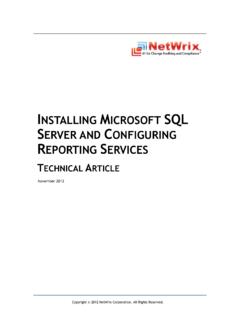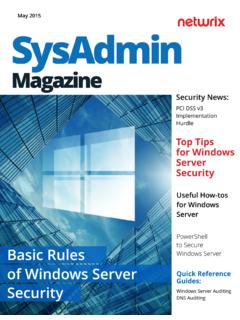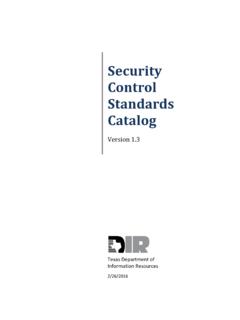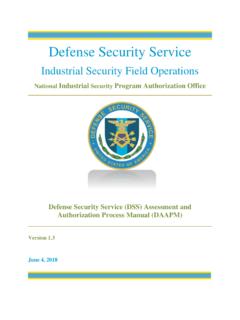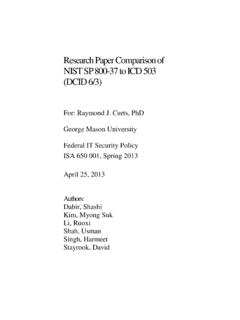Transcription of NIST SP 800-53 Controls - Netwrix
1 NIST SP 800-53 Controls and Netwrix Auditor Mapping | Toll-free: 888-638-9749 2 About FISMA / NIST The Federal Information Security Management Act of 2002 (commonly abbreviated to FISMA) is another name for Title III of the E-Government Act (public law 107-347). FISMA defines a framework for ensuring the effectiveness of security Controls over information and information systems that support federal operations. FISMA compliance is mandatory for federal agencies, their contractors and other organizations working on behalf of federal agencies. To comply with the federal standard, organizations first determine the security category of their information system in accordance with FIPS Publication 199, derive the information system impact level from the security category in accordance with FIPS 200, and then apply the appropriately tailored set of baseline security Controls in NIST Special Publication 800-53 .
2 Organizations have flexibility in applying security Controls in accordance with the guidance provided in Special Publication 800-53 . This allows organizations to tailor the relevant security Controls so that it more closely aligns with their mission and business requirements and environments of operation. The Federal Information Security Modernization Act of 2014, which is also known by the abbreviation FISMA, is the name of the public law 113 283. Enacted in 2014, this new legislation updates and modernizes the original FISMA law to address current security concerns. It puts special emphasis on continuous compliance, monitoring and mitigation, periodic risk assessment and evaluation of Controls . 3 Mapping of the NIST SP 800-53 Controls to Control Processes The following table lists some of the key NIST SP 800-53 Controls and explains how Netwrix Auditor can help your organization implement those Controls . Please note that the efforts and procedures required to establish compliance in each section may vary depending on an organization s systems configuration, internal procedures, nature of business and other factors.
3 Implementation of the Controls described below will not guarantee organizational compliance, and not all the Controls that Netwrix Auditor can possibly support are included. This mapping should be used as a reference guide to help you implement policies and procedures tailored to your organization s unique situation and needs. Family: Access Control Control Description Control Process AC-2 Account Management The organization: (a) Identifies and selects the following types of information system accounts to support organizational missions/business functions: [Assignment: organization-defined information system account types]; (b) Assigns account managers for information system accounts; (c) Establishes conditions for group and role membership; (d) Specifies authorized users of the information system, group and role membership, and access authorizations ( , privileges) and other attributes (as required) for each account; (e) Requires approvals by [Assignment: organization-defined personnel or roles] for requests to create information system accounts.
4 (f) Creates, enables, modifies, disables, and removes information system accounts in accordance with [Assignment: organization-defined procedures or conditions]; (g) Monitors the use of information system accounts; (h) Notifies account managers: 1. When accounts are no longer required; 2. When users are terminated or transferred; and Access Control Role and Group Assignment Personnel Status Changes 4 3. When individual information system usage or need-to-know changes; (i) Authorizes access to the information system based on: 1. A valid access authorization; 2. Intended system usage; and 3. Other attributes as required by the organization or associated missions/business functions; (j) Reviews accounts for compliance with account management requirements [Assignment: organization-defined frequency]; and (k) Establishes a process for reissuing shared/group account credentials (if deployed) when individuals are removed from the group.
5 AC-2 Account Management (Control Enhancements) (1) Automated system account management The organization employs automated mechanisms to support the management of information system accounts. Access Control Account Management Audit Account Usage Monitoring (3) Disable inactive accounts The information system automatically disables inactive accounts after [Assignment: organization-defined time period]. Access Control Inactive Accounts (9) Restrictions on use of shared / group accounts The organization only permits the use of shared/group accounts that meet [Assignment: organization-defined conditions for establishing shared/group accounts]. Access Control Account Usage Monitoring (11) Usage conditions The information system enforces [Assignment: organization-defined circumstances and/or usage conditions] for [Assignment: organization-defined information system accounts]. Access Control Account Usage Monitoring 5 (12) Account monitoring / Atypical usage The organization: (a) Monitors information system accounts for [Assignment: organization-defined atypical usage]; and (b) Reports atypical usage of information system accounts to [Assignment: organization-defined personnel or roles].
6 Access Control Account Usage Monitoring (13) Disable accounts for high-risk individuals The organization disables accounts of users posing a significant risk within [Assignment: organization-defined time period] of discovery of the risk. Access Control Account Usage Monitoring AC-3 Access Enforcement The information system enforces approved authorizations for logical access to information and system resources in accordance with applicable access control policies. Access Control Access Enforcement AC-6 Least Privilege The organization employs the principle of least privilege, allowing only authorized accesses for users (or processes acting on behalf of users) which are necessary to accomplish assigned tasks in accordance with organizational missions and business functions. Access Control Role and Group Assignment Least Privilege AC-7 Unsuccessful Logon Attempts The information system: (a) Enforces a limit of [Assignment: organization-defined number] consecutive invalid logon attempts by a user during a [Assignment: organization-defined time period]; and (b) Automatically [Selection: locks the account/node for an [Assignment: organization-defined time period]; locks the account/node until released by an administrator; delays next logon prompt according to [Assignment: organization-defined delay algorithm]] when the maximum number of unsuccessful attempts is exceeded.
7 Identification and Authentication Authenticator Management 6 AC-17 Remote Access The organization: (a) Establishes and documents usage restrictions, configuration/connection requirements, and implementation guidance for each type of remote access allowed; and (b) Authorizes remote access to the information system prior to allowing such connections. Access Control Remote Access AC-18 Wireless Access The organization: (a) Establishes usage restrictions, configuration/ connection requirements, and implementation guidance for wireless access; and (b) Authorizes wireless access to the information system prior to allowing such connections. Access Control Wireless Access AC-20 Use of External Information Systems The organization establishes terms and conditions, consistent with any trust relationships established with other organizations owning, operating, and/or maintaining external information systems, allowing authorized individuals to: (a) Access the information system from external information systems; and (b) Process, store, or transmit organization-controlled information using external information system.
8 Access Control Use of External Information Systems 7 Family: Audit and Accountability Control Description Control Process AU-3 Content of Audit Records The information system generates audit records containing information that establishes what type of event occurred, when the event occurred, where the event occurred, the source of the event, the outcome of the event, and the identity of any individuals or subjects associated with the event. Audit and Accountability Audit Record Generation AU-4 Audit Storage Capacity The organization allocates audit record storage capacity in accordance with [Assignment: organization-defined audit record storage requirements]. Audit and Accountability Audit Record Generation AU-5 Response to Audit Processing Failures The information system: (a) Alerts [Assignment: organization-defined personnel or roles] in the event of an audit processing failure; and (b) Takes the following additional actions: [Assignment: organization-defined actions to be taken ( , shut down information system, overwrite oldest audit records, stop generating audit records)].
9 Audit and Accountability Response to Audit Processing Failures AU-6 Audit Review, Analysis, and Reporting The organization: (a) Reviews and analyzes information system audit records [Assignment: organization-defined frequency] for indications of [Assignment: organization-defined inappropriate or unusual activity]; and (b) Reports findings to [Assignment: organization-defined personnel or roles]. Audit and Accountability Audit Trail Review 8 AU-7 Audit Reduction and Report Generation The information system provides an audit reduction and report generation capability that: (a) Supports on-demand audit review, analysis, and reporting requirements and after-the-fact investigations of security incidents; and (b) Does not alter the original content or time ordering of audit records. Audit and Accountability Report Generation and Audit Reduction AU-8 Time Stamps The information system: (a) Uses internal system clocks to generate time stamps for audit records; and (b) Records time stamps for audit records that can be mapped to Coordinated Universal Time (UTC) or Greenwich Mean Time (GMT) and meets [Assignment: organization-defined granularity of time measurement].
10 Audit and Accountability Audit Record Generation AU-9 Protection of Audit Information The information system: The information system protects audit information and audit tools from unauthorized access, modification, and deletion. Audit and Accountability Protection of Audit Information AU-11 Audit Record Retention The organization retains audit records for [Assignment: organization-defined time period consistent with records retention policy] to provide support for after-the-fact investigations of security incidents and to meet regulatory and organizational information retention requirements. Audit and Accountability Audit Record Retention 9 AU-12 Audit Generation The information system: (a) Provides audit record generation capability for the auditable events defined in AU-2 a. at [Assignment: organization-defined information system components]; (b) Allows [Assignment: organization-defined personnel or roles] to select which auditable events are to be audited by specific components of the information system; and (c) Generates audit records for the events defined in AU-2 d.

